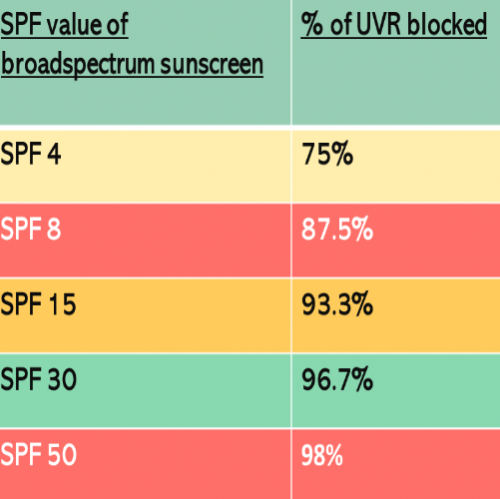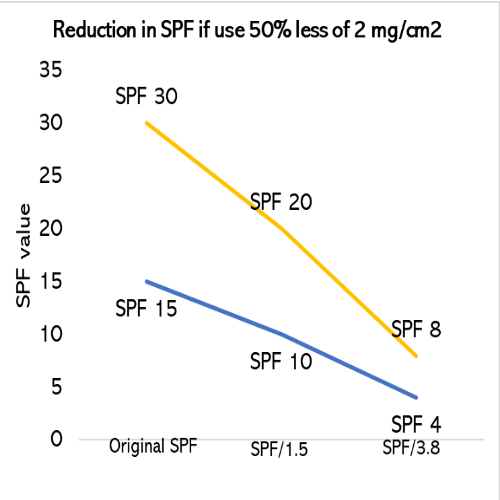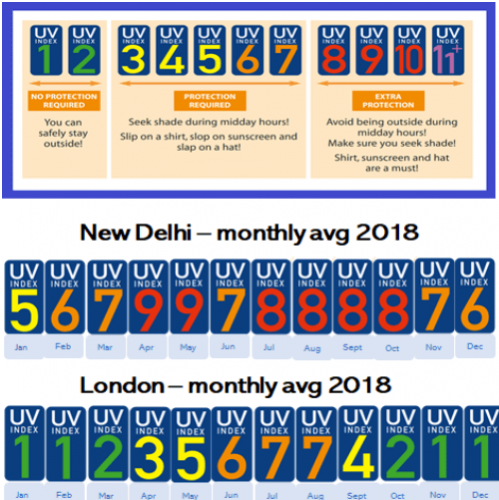I can’t help but notice the growing number of SPF 100 sunscreens in the US or India.
But why do Europeans cap their sunscreens at SPF 50+? And why do the Australians and most cancer organisations recommend a minimum of SPF 30?
Is SPF 30 any different to SPF 15?
Today’s blog is to help you understand the raison d’être behind why I suggest Indians use SPF 30, 365 days a year. Trust me, it’s not what you think it is.
1) How much UVR is blocked?
Sun Protection Factor (SPF) number, tells you how long it takes for your skin to burn (redness or erythema) with sunscreen compared to when no product is used at all.
Another way to look at SPF is how much UV radiation is blocked.

An SPF50+ product blocks about 98% of UVR and SPF 15 blocks 93.3%. Let’s be honest its really not that different.
2) The answer has nothing to do with SPF, but is behaviourial
The SPF of sunscreens are measured under strict conditions in a lab and an important premise is the quantity of sunscreen applied is 2 mg/cm2
The SPF value ONLY holds if you apply the correct amount of sunscreen, which is bizarre because I haven’t met a single person who can eyeball 2 mg/cm2 correctly.
Therefore, it should come as no surprise that studies persistently show:
- People typically apply 0.5 to 1.5 mg/cm2 of sunscreen in real life instead of the 2 mg/cm2 dosage prescribed in SPF test.
- The cosmetic elegance of a sunscreen determine how much we apply. If a sunscreen is easier and less chalky and less gunky, people apply closer to the 2 mg/cm2 dose.
3) Why is applying LESS sunscreen a bad idea?
At the expense of sounding like a broken record, SPF is tested in a lab and the entire existence of an SPF test depends on the quantity of sunscreen being 2 mg/cm2.
Naturally, its not rocket science that applying LESS sunscreen reduces the SPF protection.
But here is the thing:
..It can be seen that when the dose (i.e., 2 mg/cm2) is halved, the SPF is divided by a variable factor according to the product, from 1.5 to 3.8.
Influence on SPF of the quantity of sunscreen product applied (full reference in notes)
In plain English…..
Applying 50 per cent of 2mg/cm2 reduces SPF value in a non-linear manner.

As you can see SPF 15 very quickly becomes SPF 10 or SPF 4.
This is exactly why I don’t suggest anyone use SPF 15 or SPF 20….
4) Why don’t I like SPF 100?
Again, the answer has more to do with our behaviour than the product itself.
The International Cancer Agency has found that when people use high SPF sunscreen products, they intentionally expose themselves to larger doses of UVR.
I take that to mean that folks all of a sudden think they have some type UVR resistant skin. If they never normally step out during mid-day Chennai or New Delhi summer’s, they all of a sudden think that wearing SPF 100+ allows them to do so.
It doesn’t. Sunscreen just reduces the exposure to UVR – it doesn’t eliminate UVR risk. And as UVR damage is cumulative, intentional exposure to UVR only increases the risk of photoaging (wrinkles, hyper-pigmentation, loss of elasticity etc etc).
P.S. The Solar UV Index (UVI)
The Solar UV Index or UVI number essentially measures the intensity of UVR at a given moment.
The UVI number measures erythemal UVR and therefore, focuses on avoiding sunburn. Most countries, make publicly available a Solar UV Index, which is a single digit that’s used to give sun protection guidance.
This is the monthly UVI average for New Delhi and London for 2018.

If you live in New Delhi, 12 months of a year you have to wear sunscreen and in London its for 4 months of the year.
As most of my readers live in India, I suggest an SPF 30.
What’s my position
Just to put the fear of the Sunscreen God in you (again), you cannot afford not to use sunscreen and your skin (and wallet) will thank you in the years to come for using sunscreen every day of the year.
I suggest SPF 30 because you and I will consistently NEVER apply the correct amount of sunscreen 365 days a year. Also, I don’t want to encourage UVR risky behaviour, so I steer away from SPF 100.
That’s it from me. Drop me a line at email@happyskindays.com if you have any comments or questions.
See also Myths About Sun protection
Notes
In 2002, Cosmetics Europe (formally Colipa) proposed an SPF cap at 50+ (SPF equal to 60 or more)
M Brown, A. Chardon “Justification for an SPF Cap” Nov 2002, Colipa
Diffey, B.L. and Grice, J. “The influence of sunscreen type on photoprotection.” Br. J. Dermatol. 137, 103–105 (1997)
Lademann, J., Schanzer, S., Richter, H. et al. „Sunscreen application at the beach.” J. Cosmet. Dermatol. 3, 62–68 (2004)
Lademann, J., Rudolph, A., Jacobi, U., Weigmann, H.-J., Schaefer, H. and Sterry, W. “Influence of nonhomogeneous distribution of topically applied UV filters on sun protection factors.” J. Biomed. Opt. 9, 1358 (2004).
Bimczok R, Gers-Barlag H, Mundt C et al. “Influence of applied quantity of sunscreen products on the sun protection factor – a multicenter study organized by the DGK Task Force Sun Protection.” Skin Pharmacol Physiol 2007; 20: 57–64
171. Autier, P., M. Boniol, and J. F. Dore, “Sunscreen Use and Increased Duration of Intentional Sun Exposure: Still a Burning Issue,” International Journal of Cancer, vol. 121(1), pp. 1-5, 2007.
Couteau C, Paparis E, El-Bourry-Alami S, Coiffard LJ, “Influence on SPF of the quantity of sunscreen product applied,” Int J Pharm. 2012 Nov 1;437(1-2):250-2. doi: 10.1016/j.ijpharm.2012.08.019. Epub 2012 Aug 20.
Hao Ou-Yang & Thomas Shyr, “Letter to the Editor on Dose–response of SPF values: linear or exponential?” Photodermatol Photoimmunol Photomed 2016; 32: 52–54 doi:10.1111/phpp.12210